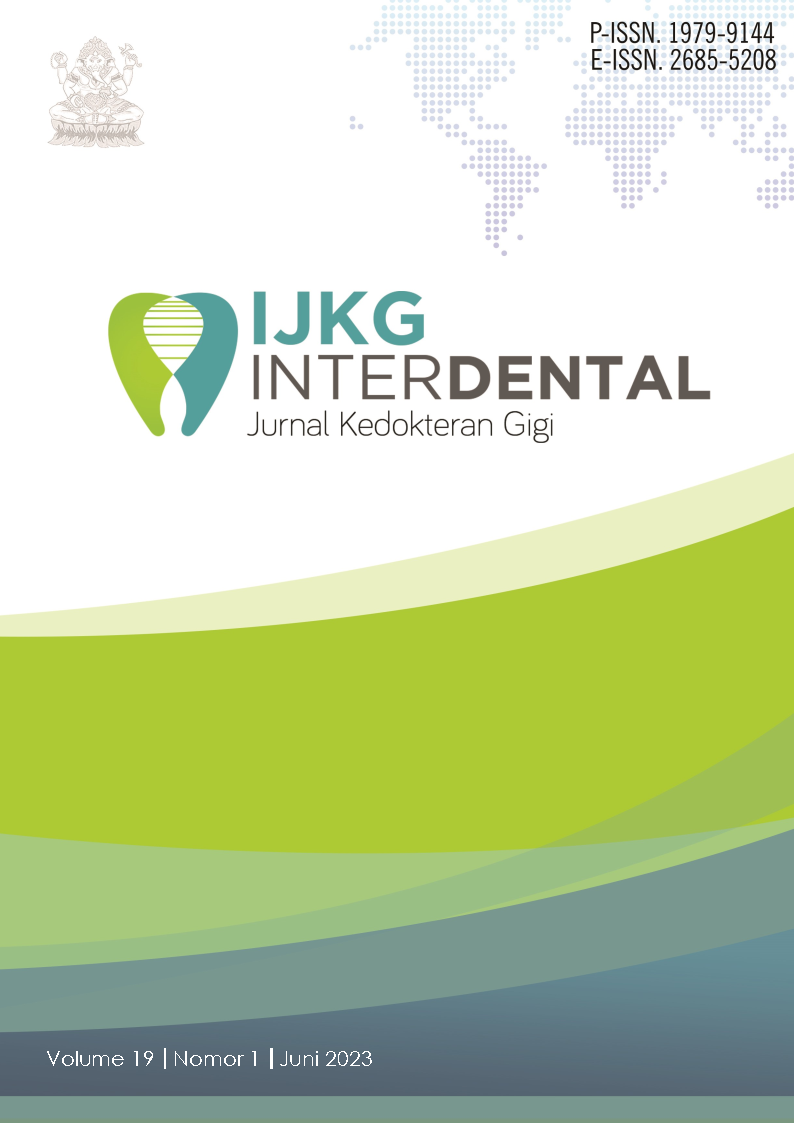THE EFFECT OF SMOKING HABITS ON THE OCCURRENCE OF BRUXISM: A RAPID REVIEW
PENGARUH KEBIASAAN MEROKOK TERHADAP TERJADINYA BRUXISM : A RAPID REVIEW
DOI:
https://doi.org/10.46862/interdental.v19i1.6351Keywords:
Awake bruxism, bruxism, rapid review, , sleep bruxism, smoking habitAbstract
Introduction: Bruxism is a parafunctional habit in the oral cavity area. Bruxism is distinguished from awake and sleep bruxism. Bruxism is caused by various etiological factors. Smoking habits are considered is one of the exogenous factors that cause bruxism. This study aims to determine the effect of smoking habits on bruxism. Review: This study was conducted using the rapid review of articles reporting the effect of smoking on the occurrence of bruxism. Article searches were conducted through PubMed, Google Scholar, and EBSCO Host from October until November 2022. Article screening was carried out by checking for duplication, reading titles and abstracts, and reading the contents of the entire text. A total of 1257 articles were identified at the initial stage of the research with total of 6 articles included into rapid review criteria. Research on articles analyzed qualitatively shows that smoking habits affect occurrence of bruxism in most of the articles reviewed. As many as 2 articles prove smoking influences bruxism in general and as many as 2 articles proving that smoking affects awake bruxism. Conclusion: Smoking habits have an influence on the occurrence of bruxism in general.
Downloads
References
Melo G, Duarte J, Pauletto P, Porporatti AL, Stuginski‐Barbosa J, Winocur E. Bruxism: An umbrella review of systematic reviews. J Oral Rehabil 2019; 46(7): 666-90.
Rintakoski K, Kaprio J. Legal psychoactive substances as risk factors for sleep-related bruxism: A nationwide finnish twin cohort study. Alcohol and Alcoholism 2013; 48(4): 487–94.
Quadri MFA, Mahnashi A, Al Almutahhir A, Tubayqi H, Hakami A, Arishi M. Association of awake bruxism with khat, coffee, tobacco, and stress among Jazan University students. Int J Dent 2015; 2015(1): 1–5.
Penelitian B, Pengembangan D, Kementerian K, Ri K. Riset kesehatan dasar RISKESDAS 2013. [Internet]. Kemenkes RI. 2013 [cited November 2022].Available from: https://pusdatin.kemkes.go.id/resources/download/general/Hasil%20Riskesdas%202013.pdf
Abe Y, Suganuma T, Ishii M, Yamamoto G, Gunji T, Clark GT. Association of genetic, psychological and behavioral factors with sleep bruxism in a Japanese population. J Sleep Res 2012; 21(3): 289–96.
de Leeuw R, Eisenlohr-Moul T, Bertrand P. The association of smoking status with sleep disturbance, psychological functioning, and pain severity in patients with temporomandibular disorders. J Orofac Pain 2013; 27(1): 32–41.
Bhatia R, Rajesh C, Saloni S. A hospital-based case–control study to explore the association of bruxism and cardiovascular diseases in Himachal Pradesh, India.IJCD 2021; 9(2): 208-14.
Breckenridge CB, Berry C, Chang ET, Sielken RL, Mandel JS. Association between Parkinson’s Disease and cigarette smoking, rural living, well-water consumption, farming and pesticide use: Systematic review and meta-analysis. PLoS One 2016; 11(4).
Kuhn M, Türp JC, Türp JC, Myoarthropathien MAA, Orofazialer Schmerz. Risk factors for bruxism. Swiss Dent J 2018; 128(2): 118-24.
Alharby A, Alzayer H, Almahlawi A, Alrashidi Y, Azhar S, Sheikho M. Parafunctional behaviors and its effect on dental bridges. J Clin Med Res 2018; 10(2): 73–6.
Rusted JM, Sawyer R, Jones C, Trawley SL, Marchant NL. Positive effects of nicotine on cognition: the deployment of attention for prospective memory. Psychopharmacology (Berl) 2009; 202(1–3): 93–102.
Demjaha G, Kapusevska B, Pejkovska-Shahpaska B. Bruxism unconscious oral habit in everyday life. Open access Maced J Med Sci 2019; 7(5): 876–81.
Van Selms MKA, Visscher CM, Naeije M, Lobbezoo F. Bruxism and associated factors among Dutch adolescents. Community Dent Oral Epidemiol 2013; 41(4): 353–63.
Winocur E, Messer T, Eli I, Emodi-Perlman A, Kedem R, Reiter S. Awake and sleep bruxism among Israeli adolescents. Front Neurol 2019; 10(1): 443-51.
Dumitru R. The Clinical Neurophysiological Pattern in Patient with Bruxism and Self-Help Options Thesis. Chisinau; Department of Therapeutic Dentistry of the State University of Medicine and Pharmacy; 2019; h. 4-18.
Berger M, Litko M, Ginszt M, Alharby H, Szkutnik J, Majcher P. Use of common stimulants and awake bruxism – a survey study. Pol J Public Health 2016; 126(3): 130–3.
Alajbeg Iz, Zuvela A, Tarle Z. Risk factors for bruxism among Croatian navy employees. J Oral Rehabil. 2012; 39(9): 668–76.
Gümüş A, Kayhan S, Cinarka H, Baydur S, Gıakoup D, Şahin Ü. The relationship between cigarette smoking and obesity. J Exp Clin Med. 2014; 30(4): 311–5.
Guo H, Wang T, Niu X, Wang H, Yang W, Qiu J, et al. The risk factors related to bruxism in children: A systematic review and meta-analysis. Arch Oral Biol. 2018; (86)1: 18–34.
El-Sherbiny NA, Elsary AY. Smoking and nicotine dependence in relation to depression, anxiety, and stress in Egyptian adults: A cross-sectional study. J Family Comm Med. 2022; 29(1): 8–16.
Downloads
Published
How to Cite
Issue
Section
License
- Every manuscript submitted to must observe the policy and terms set by the Interdental Jurnal Kedokteran Gigi (IJKG)
- Publication rights to manuscript content published by the Interdental Jurnal Kedokteran Gigi (IJKG) is owned by the journal with the consent and approval of the author(s) concerned.
- Full texts of electronically published manuscripts can be accessed free of charge and used according to the license shown below.













